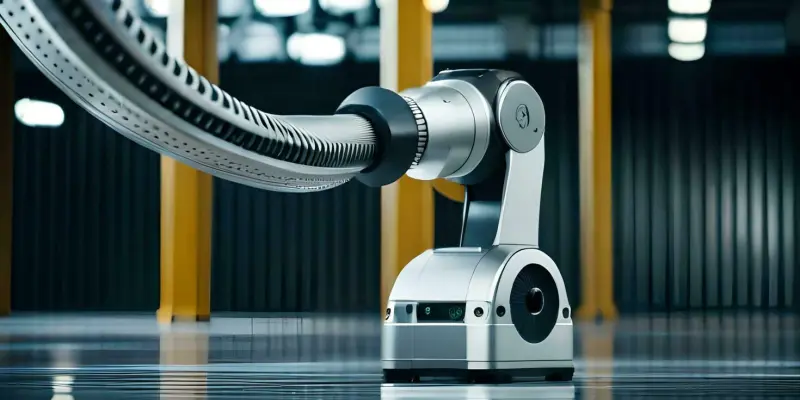In the rapidly evolving field of automation, the GRIP-tape gripper system has emerged as a groundbreaking innovation by University of California San Diego researchers. This system draws inspiration from the simplicity and functionality of a measuring tape, rather than mimicking the intricate dexterity of human hands. With the ability to replace repetitive human tasks across various industries, GRIP-tape holds significant potential in transforming sectors like agriculture. The design includes two steel “fingers” resembling measuring tape, capable of extending, retracting, and rotating, offering versatile gripping capabilities. By shifting away from traditional human-like designs, this innovative system utilizes simple linear motions that can be manipulated by independent electric motors. Applications like unscrewing bottles or using screwdrivers highlight the potential of this design. GRIP-tape showcases a streamlined approach that could redefine how robotic grips function, suggesting a shift away from the conventional emulation of human morphology in robotics.
Advancements in Robotic Design
The GRIP-tape gripper represents a significant departure from conventional designs prevalent in robotics, challenging the notion that human morphology should serve as the default standard. By opting for a design centered around linear motions rather than complex hand-like mechanisms, the GRIP-tape provides a simpler yet highly effective alternative. Each “finger” operates via independent electric motors, granting the flexibility needed for tasks ranging from unscrewing containers to executing intricate screwdriver maneuvers. This innovation reflects an understanding that simplicity often begets efficiency in robotic applications. The emphasis on straightforward mechanics not only reduces the complexity but also lowers the cost, making it more accessible for varied industries. Moreover, this approach underscores the potential for customized designs that cater to specific functions, paving the way for a new era of specialized automation solutions tailored to distinct tasks. The simplicity embedded within the GRIP-tape gripper’s design translates into multiple practical advantages, evident in its pilot tests. Compared to traditional hand-shaped grippers, GRIP-tape’s straightforward structure offers enhanced adaptability and precision, optimizing for a wide range of applications. This structural simplicity reduces the likelihood of mechanical failure, highlighting the design’s durability in real-world scenarios. As the system continues through laboratory testing, its effectiveness becomes increasingly evident, providing clear validation for this design philosophy. Furthermore, the potential to incorporate materials beyond steel ensures adaptability to different operational environments. As developments progress, GRIP-tape is poised to impact industries from agricultural automation to healthcare, where precision can yield substantial benefits. The continuous refinement of this innovation aims to maintain its edge, presenting an adaptable and enduring solution that meets the evolving demands of modern automation.
Expanding the Scope of Automation
With its initial success, the GRIP-tape gripper system is poised to broaden the automation landscape in fields beyond those initially anticipated. The system’s application in agriculture, especially in tasks like soft fruit picking, demonstrates its ability to handle delicate materials with care and precision. This capacity for gentle manipulation extends its uses to industries requiring detail-oriented handling, opening doors to significant innovation in automation processes. As robotic technology continues its relentless march forward, the GRIP-tape highlights the importance of thinking beyond traditional methods. By challenging conventional paradigms, it offers invaluable insights into elevating automation’s efficiency. Through the reevaluation of robotics design principles, industry players can realize greater levels of proficiency and effectiveness in everyday tasks. As a result, GRIP-tape is not only a technological marvel but a catalyst that encourages further revolution in automation sectors worldwide. Robotic innovation becomes increasingly vital as industries face mounting pressure to automate tasks traditionally performed by humans, mitigating issues like labor shortages. GRIP-tape provides a powerful argument for adopting designs that prioritize function over form. It sets an example of how robots might be designed, manufactured, and deployed in the years to come. By sidestepping the complexities of human replication, this gripper system exemplifies a conceptual breakthrough, leading to innovations that prioritize practical outcomes. This sheds light on how adaptive automation solutions can recalibrate industry standards, surpassing limitations imposed by conventional gripper mechanisms. The system’s implication goes beyond its immediate applications; it encourages a holistic rethinking of inclusive innovation in robotics. The GRIP-tape’s versatility and simplicity embody a key paradigm shift in robotics, offering a glimpse of how technology can adapt to fundamentally shift longstanding industry practices.
Looking Forward
In the ever-evolving realm of automation, the GRIP-tape gripper system, developed by researchers at the University of California San Diego, stands out as a significant innovation. Unlike traditional robotic systems that attempt to replicate the complex dexterity of human hands, GRIP-tape draws inspiration from the straightforward yet effective design of a measuring tape. This system’s potential is vast, particularly in industries plagued by repetitive tasks like agriculture. The design boasts two steel “fingers” similar to measuring tapes, which can extend, retract, and rotate to handle diverse gripping tasks. By diverging from conventional human-like designs, GRIP-tape employs simplistic linear movements, powered by independent electric motors. This allows it to excel in tasks such as unscrewing bottles or using screwdrivers. With its streamlined approach, GRIP-tape could revolutionize robotic gripping technology, hinting at a new direction that moves away from the traditional endeavor of mimicking human form in the world of robotics.

